To learn about the The D’Argenio Collection of Coins and Antiquities please use the tabs to the left to navigate through the exhibition.
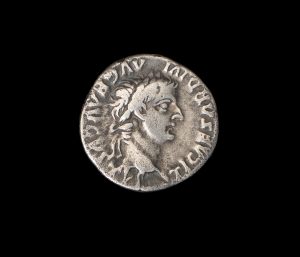
Silver
14 – 37 C.E.
2015.16.0058
Gift of Ron D’Argenio
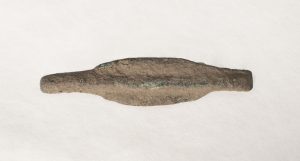
Bronze
6th to 5th century B.C.E.
2015.16.0028
Gift of Ron D’Argenio
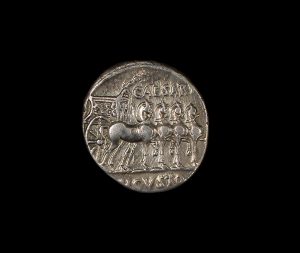
Silver
27 – 14 B.C.E.
2015.16.0054
Gift of Ron D’Argenio
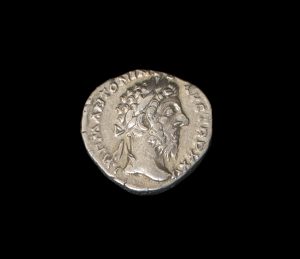
Silver
161 – 180 C.E.
2015.16.0106
Gift of Ron D’Argenio
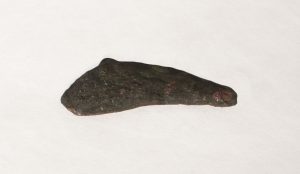
Bronze
6th to 5th century B.C.E.
2015.16.0027
Gift of Ron D’Argenio
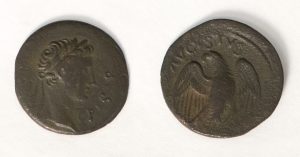
Copper
27 B.C.E. – 14 C.E.
2015.16.0052
Gift of Ron D’Argenio
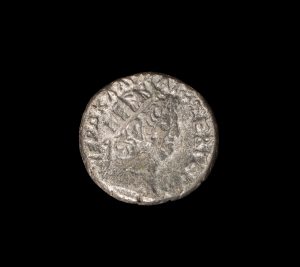
Silver and copper alloy
64 – 65 C.E.
2015.16.0066
Gift of Ron D’Argenio
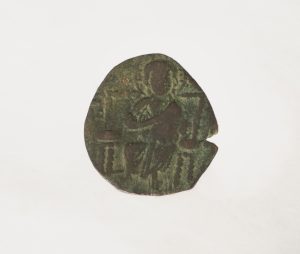
Bronze
8 – 9th century C.E.
2015.16.0018
Gift of Ron D’Argenio
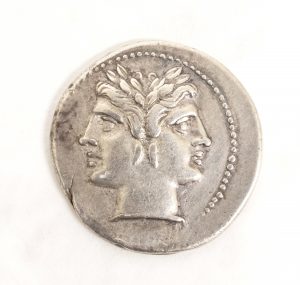
Silver
225 – 212 B.C.E.
2015.16.0305
Gift of Ron D’Argenio
Marcus Claudius Marcellus
Under the Roman Republic, coins were not adopted as quickly as in other regions of the Mediterranean. The denarius was the predominant coin and remained in circulation for almost 450 years. Coins of this period often feature images of Roman gods on the front (obverse), to conflate their virtues with those of the rulers. This coin was most likely issued during the second Punic War when Marcus Claudius Marcellus – a general being groomed to be a caesar – led Roman troops to victory. Marcellus died of illness before he was able to ascend to leadership.
This coin features the image of the god Janus, who presided over the beginning and ending of conflict, and hence, war and peace in ancient Roman religion and myth.
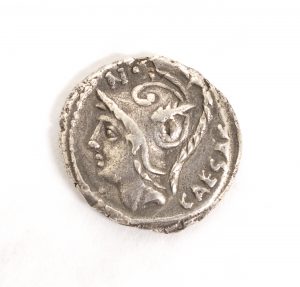
Silver
103 B.C.E.
2015.16.0315
Gift of Ron D’Argenio
Julius Caesar
Julius Caesar was known as a skilled politician, gifted orator and military general. A popular leader, he initiated a program of social and governmental reforms including; the extension of citizenship to those living in Roman territories, support for military veterans, redistribution of property to the poor, and the creation of the Julian calendar, the same one we use today. Though he favored Republican ideals towards the beginning of his reign, he was assassinated, in part, for his increasingly dictatorial manner of rule. The coin features the image of Mars, god of war, wearing a crested helmet.
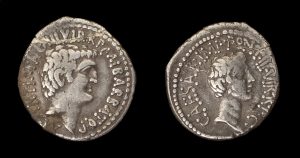
Silver
40 – 39 B.C.E.
2015.16.0354
Gift of Ron D’Argenio
Antony and Octavian
The Battle of Actium was the decisive confrontation in the final civil war of the Roman Republic. Marc Antony betrayed the Romans by siding with Queen Cleopatra of Egypt against Octavian’s forces who represented Rome’s interests. Octavian triumphed. This front of the coin depicts the bust of Marc Antony (left) and the reverse depicts the bust of Octavian (right) prior to the dissolution of their alliance.
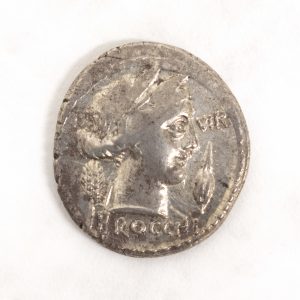
Silver
63 B.C.E.
2015.16.0346
Gift of Ron D’Argenio
Lucius Furia Brocchus
The Furia family (or gens) was one of the oldest and most distinguished in the Roman Republic. This coin was minted when Lucius Furius Brocchus was moneyer. This family held many of the highest offices. The obverse of this coin features the bust of Ceres, goddess of agriculture and fertility. She is flanked by her attributes; on the left, an ear of corn and to her right, a grain of barley.
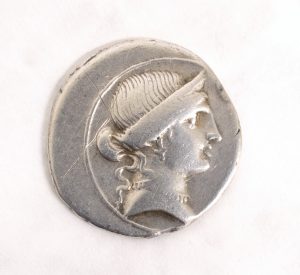
Silver
30 – 27 B.C.E.
2015.16.0045
Gift of Ron D’Argenio
Octavian
Augustus, born Gaius Octavius, was the very first emperor of the Roman Empire, ruling from 27 B.C.E. until his death in 14 C.E. He was the great-nephew of Julius Caesar. Augustus is remembered as a successful ruler, expanding Roman territory, establishing tax reforms, developing a system of roadways and instituting an official network of couriers. He also instituted police and fire departments, as well as a standing army. His rule, despite the empire’s militaristic expansion, is remembered as one of considerable peace and progress. His adopted son and stepson, Tiberius, succeeded him in death.
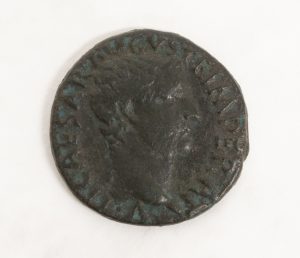
Copper
14 – 37 C.E.
2015.16.0057
Gift of Ron D’Argenio
Tiberius
Renowned as one of the greatest Roman generals, the length of Tiberius’ 22 ½ year reign was surpassed only by that of Antoninus and Augustus. Tiberius was related to many emperors including including; Augustus (step-father), Caligula (grand-nephew and adopted grandson), Nero (great-grand nephew) and Claudius (nephew).
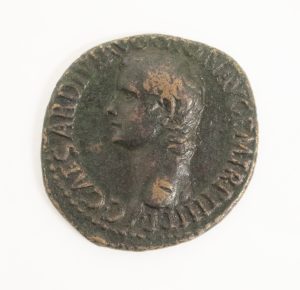
Copper
37 – 41 C.E.
2015.16.0060
Gift of Ron D’Argenio
Caligula
Caligula became emperor after the death of his adoptive grandfather Tiberius. Known historically for his personal excesses and unrestrained power, Caligula was assassinated by a group of conspirers comprised of government officials, soldiers and courtiers.
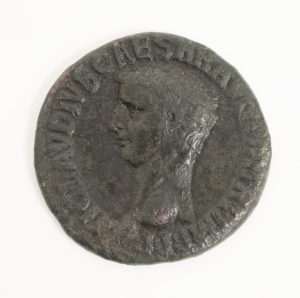
Copper
41 – 54 C.E.
2015.16.0063
Gift of Ron D’Argenio
Claudius
Born in Lugdunum (present day Lyon, France), Claudius was the first emperor that was not born in Rome. His father, a high-ranking Roman military officer, was stationed in the outpost and later died unexpectedly during a campaign in Germania. Claudius was known for his public works projects, especially the completion of three aqueducts – the Aqua Claudia, Aqua Anio Novus and Aqua Virgo. Portions of all three still exist.
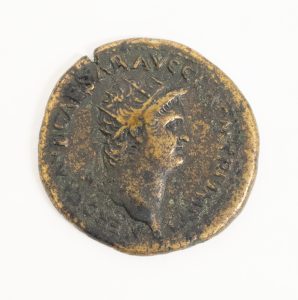
Copper and brass
54 – 68 C.E.
2015.16.0067
Gift of Ron D’Argenio
Nero
Nero became emperor in 54 C.E. at the age of 16. His ascent to the throne was marked by a series of machinations by his mother Julia Agrippina, great-granddaughter of the emperor Augustus, who is said to have poisoned the emperor Claudius and his son Brittanicus, Nero’s rival for the throne. Nero’s early reign was looked upon quite favorably. He outlawed capital punishment, lowered taxes and promoted the arts. The later years of his rule were marked by corruption, extravagance and tyranny – behaviors that are said to have escalated after his murders of his mother and step-brother.
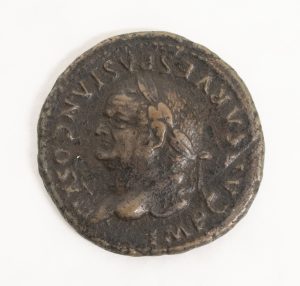
Copper
69 – 79 C.E.
2015.16.0074
Gift of Ron D’Argenio
Vespasian
The son of a tax collector, Vespasian instituted a series of tax reforms to restore the Roman Empire’s finances after military success in Judaea. He then began several ambitious civic projects, including the building of The Flavian Amphitheater, the largest ever built. Today it is known as the Roman Colosseum. The colosseum, which could accommodate over 50,000 people, was used for many sorts of civic functions including mock naval battles, gladiator fights and dramatic performances.
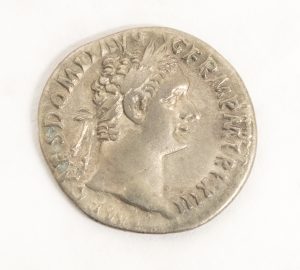
Silver
81 – 96 C.E.
2015.16.0078
Gift of Ron D’Argenio
Domitian
Though the Roman Republic had been dismantled by the time Domitian became emperor, the Roman Empire had not dispensed with the outward pretense of a republican state. Domitian put to rest this notion, officially rendering senatorial powers obsolete. Domitian openly governed as an absolute monarch, his rule pervading into matters of cultural and moral authority in addition to his political role.

Silver
98 – 117 C.E.
2015.16.0083
Gift of Ron D’Argenio
Trajan
Trajan was appointed emperor in 98 C.E. by his predecessor Domitian. Trajan, who rose through the military ranks to become emperor, was popular with his citizenry for his dogged expansion of the Roman Empire. Under his leadership, the empire was territorially at its largest. He was also well-liked due to his civic projects which included the building of Trajan’s Forum – a civic complex used for a variety of social, devotional and governmental purposes – and Trajan’s Market.
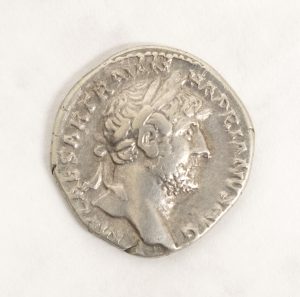
Silver
117 – 138 C.E.
2015.16.0088
Gift of Ron D’Argenio
Hadrian
A first cousin of the emperor Trajan, Hadrian did not seek expansion of the empire, but a contraction of it with an aim to unify its various peoples. In his desire to unite the empire, he initiated projects such as Hadrian’s wall, which both denoted and fortified its northern reaches in the present-day United Kingdom. Hadrian also rebuilt Rome’s famous Pantheon, a former temple to the gods.
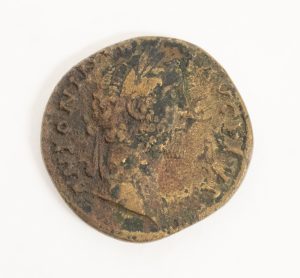
Orichalcum
138-161 C.E.
2015.16.0096
Gift of Ron D’Argenio
Antoninus
Antoninus rose to power during Hadrian’s rule and was later adopted by him before being chosen to succeed him in death. His reign was characterized by peace and prosperity, with no major military actions or incursions during this time. Antoninus presided over a period of building – providing free access to drinking water with the building of aqueducts – as well as bridges and roads. Despite his civic building campaigns, there was a considerable surplus in state coffers both during and after his rule.
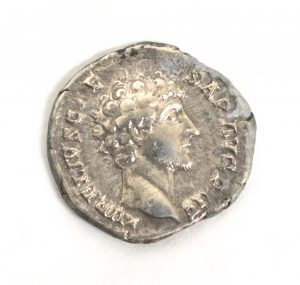
Silver
139 – 161 C.E.
2015.16.0044
Gift of Ron D’Argenio
Marcus Aurelius
The nephew of Antoninus, Marcus Aurelius was adopted by his uncle shortly before he became emperor in 138 C.E. Marcus Aurelius was a gifted military leader, defending the empire from Parthian and German enemies. Under his rule, the empire flourished and he was remembered as a good and capable leader. However, Marcus Aurelius is best recalled as a philosopher king. He wrote an influential journal entitled “Meditations.” Though it was published, it was meant to be a series of private reflections based on the emperor’s Stoic outlook and his belief in responsibility to his subjects. The book is still in print.
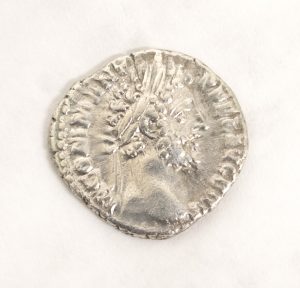
Silver
177 – 192 C.E.
2015.16.0115
Gift of Ron D’Argenio
Commodus
Commodus was just 16 years old when his father, Marcus Aurelius, appointed him co-emperor. They ruled jointly for roughly three years until his father’s death. From that point, he ruled solely for another twelve years. Commodus was highly educated but lacked military training. He was disinterested in governing, using his position to further his own desires. He fancied himself a gladiator, and the reincarnation of the god Hercules, physically imposing and a protector of the people. His megalomaniacal behavior led to a public loss of confidence, and ultimately, his assassination by one of his sparring partners.
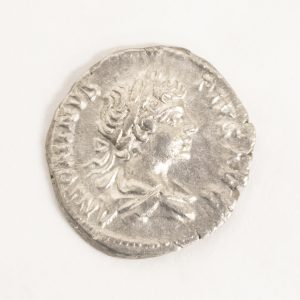
Silver
198 – 211 C.E.
2015.16.0129
Gift of Ron D’Argenio
Caracalla
Caracalla directed the building of the eponymously named Baths of Caracalla in Rome, the second largest public baths in the city. The ruins stand to this day. He is also known for an edict which granted full Roman citizenship to nearly all the free inhabitants of the empire. Despite these progressive measures, Caracalla is best remembered as one of the most tyrannical rulers in the empire’s history. He killed his brother Geta, with whom he co-ruled, and assassinated Geta’s loyalists. He also brutally massacred civilians during his many military campaigns, most notably, his execution of the city’s youth when conquering the city of Alexandria.
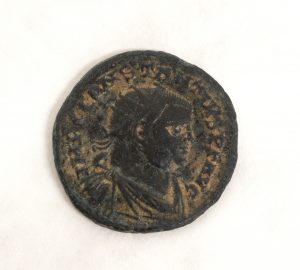
Copper
305 – 306 C.E.
2015.16.0221
Gift of Ron D’Argenio
Constantine
Constantine was the first emperor to adopt Christianity at both state and personal levels. In February 313 C.E., he signed the Edict of Milan, a proclamation of religious tolerance that ended the persecution of Christians. The edict brought over 300 years of oppression to an end, during which Christians were forced to worship in secret or risk arrest and public martyrdom. Constantine’s declaration ushered in an era when Christians could fully participate in Roman civic life.
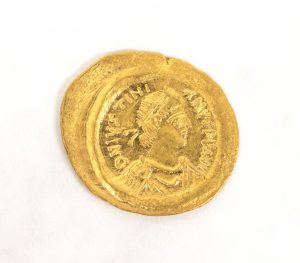
Gold
527- 565 C.E.
2015.16.0289
Gift of Ron D’Argenio
Justinian
Justinian was considered one of the greatest rulers of the late Roman and Byzantine Empires. After the fall of the Roman Empire he began campaigns in Africa and Italy to regain territory lost to the Vandals and Goths. His reunification plans also entailed massive rebuilding projects that included churches, monasteries, forts, reservoirs and bridges. He also presided over legal reforms which were compiled in the Corpus Juris Civilus, a document that included all Roman laws issued since the time of Emperor Hadrian – many of which inform today’s statutes. Justinian co-ruled with his wife Theodora. Many believe Justinian’s greatest achievements were due to her influence.